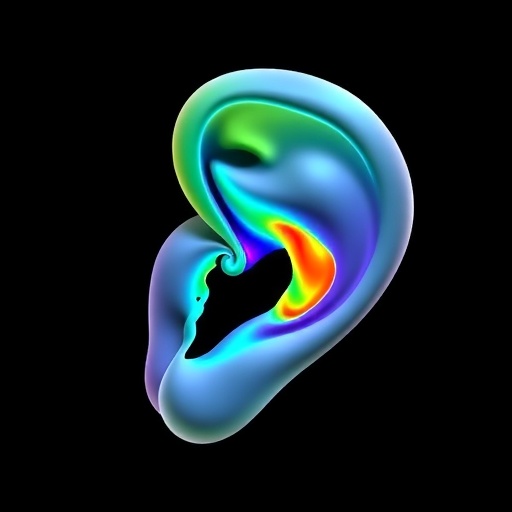Credit: Purdue University/Erin Easterling
Your chances of getting a nasty migraine increase following a spinal cord injury, thanks to a chemical messenger in the brain that spikes to toxic levels, past studies have suggested.
For treatment to get any better, researchers need to catch that split-second spike in action and closely follow its path of destruction.
Purdue University engineers have built a tiny, flexible sensor that is faster and more precise than past attempts at tracking this chemical, called glutamate. The sensor, an implantable device on the spinal cord, is primarily a research tool for testing in animal models, but could find future clinical use as a way to monitor whether a drug for neurotrauma or brain disease is working.
The group’s work appears in a forthcoming issue of Biosensors and Bioelectronics.
“When you feel like you’re running a fever, it doesn’t matter when you check your temperature – it will probably be the same for several hours. But a glutamate spike is so fast that if you don’t capture it at that moment, you miss the whole opportunity to get data,” said Riyi Shi, a professor of neuroscience and biomedical engineering in Purdue’s Department of Basic Medical Sciences, College of Veterinary Medicine and Weldon School of Biomedical Engineering.
Impact, such as from a car accident or tackle in football, can injure the spinal cord – also injuring the nerve structures that transport glutamate, which sends signals to excite nerve tissue for performing functions such as learning and memorizing.
Damaged nerve structures means that loads of glutamate leak out into spaces outside of cells, over-exciting and damaging them. Brain diseases, including Alzheimer’s and Parkinson’s, also show elevated levels of glutamate.
Devices so far either haven’t been sensitive enough to detect glutamate, fast enough to capture its spike or affordable enough for long-term research projects.
Purdue researchers are addressing these issues through implantable sensors that they have 3D printed and laser-micromachined – processes that are already used regularly in the lab and industry. A YouTube video is available at https:/
“We wanted to create a low-cost and very fast way to build these sensors so that we can easily provide researchers with a means to measure glutamate levels in vivo,” said Hugh Lee, a Purdue assistant professor of biomedical engineering, who focuses on implantable microtechnologies.
The technique allows researchers to rapidly change the size, shape and orientation of the sensors and then test in animal models without having to go through the more expensive process of microfabrication.
Measuring levels in vivo would help researchers to study how spinal cord injuries happen, as well as how brain diseases develop.
“How big of a problem is a migraine? Is too much glutamate really behind the pain, or is it that the system that cleans up glutamate is down?” Shi said.
The researchers implanted the device into the spinal cord of an animal model and then injured the cord to observe a spike. The device captured the spike immediately, whereas for current devices, researchers have had to wait 30 minutes to get data after damaging the spinal cord.
In the future, the researchers plan to create a way for the biosensors to self-clear of inflammatory cells that the body recruits to protect itself. These cells typically form a fibrous capsule around the biosensor, which blocks its sensitivity.
The technology could also allow for implanting more sensors along the spinal cord, which would help researchers to know how far glutamate spreads and how quickly.
The researchers have filed a patent application for this device with the Purdue Research Foundation Office of Technology Commercialization. The work was supported by the Global Research Outreach program of the Samsung Advanced Institute of Technology, the National Institutes of Health, and sponsored in part by the National Science Foundation under grant CNS-1726865.
This research aligns with Purdue’s Giant Leaps celebration, acknowledging the university’s global advancements made in health, longevity and quality of life as part of Purdue’s 150th anniversary. This is one of the four themes of the yearlong celebration’s Ideas Festival, designed to showcase Purdue as an intellectual center solving real-world issues.
###
ABSTRACT
Facile Fabrication of Flexible Glutamate Biosensor Using Direct Writing of Platinum Nanoparticle-Based Nanocomposite Ink
Tran N. H. Nguyen1, James K. Nolan1, Hyunsu Park1, Stephanie Lam1, Mara Fattah1, Jessica C. Page1, Hang-Eun Joe1, Martin B.G. Jun1, Hyungwoo Lee2, Sang Joon Kim2, Riyi Shi1, Hyowon Lee1
1Purdue University, West Lafayette, IN, USA
2Samsung Advanced Institute of Technology, Suwon, South Korea
doi: 10.1016/j.bios.2019.01.051
Glutamate excitotoxicity is a pathology in which excessive glutamate can cause neuronal damage and degeneration. It has also been linked to secondary injury mechanisms in traumatic spinal cord injury. Conventional bioanalytical techniques used to characterize glutamate levels in vivo, such as microdialysis, have low spatiotemporal resolution, which has impeded our understanding of this dynamic event. In this study, we present an amperometric biosensor fabricated using a simple direct ink writing technique for the purpose of in vivo glutamate monitoring. The biosensor is fabricated by immobilizing glutamate oxidase on nanocomposite electrodes made of platinum nanoparticles, multi-walled carbon nanotubes, and a conductive polymer on a flexible substrate. The sensor is designed to measure extracellular dynamics of glutamate and other potential biomarkers during a traumatic spinal cord injury event. Here we demonstrate good sensitivity and selectivity of these rapidly prototyped implantable biosensors that can be inserted into a spinal cord and measure extracellular glutamate concentration. We show that our biosensors exhibit good flexibility, linear range, repeatability, and stability that are suitable for future in vivo evaluation.
Media Contact
Kayla Wiles
[email protected]
Original Source
https:/
Related Journal Article
http://dx.




